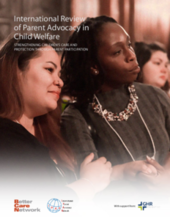Promoting parent and child participation is central to achieving children’s rights. This review of the literature and program documentation, prepared by David Tobis, Andy Bilson and Isuree Katugampala for the Better Care Network and IPAN, presents evidence on the role of parent advocacy in achieving better outcomes for children and their families in child welfare. It was written to encourage parents and their allies to work together to transform child welfare systems. This change can be achieved through parents with lived child welfare experience having an increased role and influence in the development of better child welfare systems.
Parent advocacy occurs when parents with child welfare experience influence the decisions that affect their lives. This includes advocating for and helping other parents; working in and strengthening child welfare programs; and working to change policies to improve systems and the lives of children and families. Parent advocacy aims to strengthen children’s care and protection through enabling the effective participation of parents.
Parent advocacy in child welfare has largely developed in high income countries. The review identifies over 100 parent advocacy programs in high-income countries. The report provides an overview of this development and then profiles five parents’ experiences of child welfare in high-income countries.
Additionally, it presents a survey of 15 parent advocacy programs from high-income countries. It summarises what is known about the effective implementation of parent advocacy and illustrates the many forms it can take.
The report also provides a preliminary scoping of the extent and range of parent advocacy activities in child welfare in low- and middle-income countries. Although presently parent advocacy programs in child welfare operate primarily in high-income contexts, the report considers ways that the experience and benefits of parent advocacy might be relevant for low- and middle-income countries, and how the experience in low- and middle-income countries may be beneficial to other countries.
The parent advocacy programs reviewed vary in many ways, including size, funding, range and types of activities, change strategies, extent of parent leadership and collaboration with allies, training provided, and impact. Many factors contribute to this diversity including the degree of readiness of communities to embrace parent participation, availability of funding, and whether the initiative comes from parents, from existing service providers or from activists outside the child welfare system.
Furthermore, the report reviews over 100 papers covering research and evaluation, or descriptions of parent advocacy programs. This growing research literature shows that parent advocacy takes many forms and can reduce maltreatment; reduce the need for alternative care; create stronger families; promote parental resilience and sobriety; promote a better connection with services; improve the culture in social welfare agencies; and create stronger, empowered parents.
The review makes the case for investing in an expanded and influential role for parent advocates and their organizations in child welfare decision-making and in reforms of child care and protection systems. Additional public and private resources—financial, organizational and individual—should be devoted to expanding the participation of parents in child welfare decision-making to increase the likelihood that families’ needs are met, their rights are respected and that state parties fulfil their obligations to assist families. Above all, the report seeks to instil hope by enabling parent advocates to share their experiences overcoming barriers and demonstrating their ability to change systems and achieve better outcomes. It also challenges child protection practitioners and policy makers to make parent advocacy a critical part of their strategies and programs to strengthen children’s care and protection systems.

